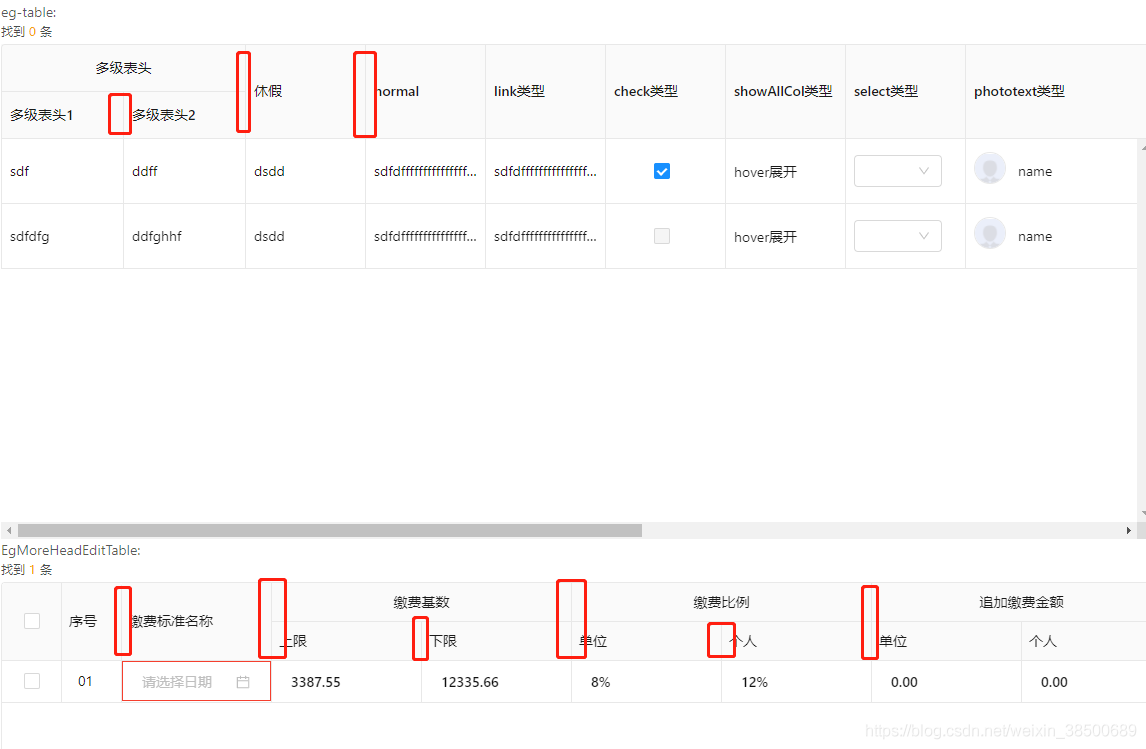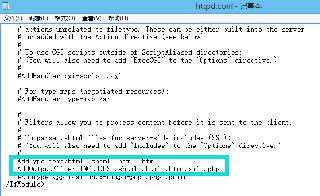ant desing vue table 實(shí)現(xiàn)可伸縮列的完整例子
這個(gè)東西本來以為手到擒來,因?yàn)樵诠倬W(wǎng)中已經(jīng)給出了例子,但是果然還是不能太信任官方,官方給出來的只能是最基礎(chǔ)的,然后我們正常的使用場(chǎng)景往往要復(fù)雜很多,比如固定列, 比如固定表頭,比如自帶checkbox列,比如多級(jí)表頭的情況。要想滿足這些情況往往需要自行開發(fā)。
1.首先蔣官方的例子copy下來,居然拖不動(dòng)。
對(duì)照了一下官方,css居然都不一樣,于是增加了第一個(gè)改動(dòng)因?yàn)閟tyle內(nèi)聯(lián)樣式自帶了 translate屬性,所以直接去掉right:0;只留left -5.height設(shè)置100%就可以。
.resize-table-th { position: relative; .table-draggable-handle { height: 100% !important; bottom: 0; left: -5px !important; cursor: col-resize; touch-action: none; position: absolute; } }
2.這回可以看到每次拖拽后translate屬性實(shí)時(shí)在變化,但是單元格并沒有變寬移動(dòng)。
于是又是檢查了元素,發(fā)現(xiàn)th的width在變化,但是colGroup的width屬性沒有變。于是開啟了尋找對(duì)應(yīng)的colGroup的子元素col之旅,最后找到了,然后就是一頓操作在draging的時(shí)候同時(shí)修改了 colGroup的col的width屬性。這樣就可以跟著變化了。
3.接下來我發(fā)現(xiàn)在固定列和固定表頭的情況下拉伸會(huì)出現(xiàn)bug。
查看代碼發(fā)現(xiàn)當(dāng)為固定列或者固定表頭的情況下實(shí)際上thead和tbody是在不同的 table上,這時(shí)候就需要找到所有的colGroup測(cè)col,改變width。這樣就處理了固定表頭的拉伸。但是固定列的情況還是需要另外設(shè)置css ,找到table-fixed-left重新設(shè)置寬度。
下面是一些代碼根據(jù)當(dāng)前的th,判斷th是父元素的第幾個(gè)孩子節(jié)點(diǎn),對(duì)應(yīng)到colGroup的第幾個(gè)col節(jié)點(diǎn)
const loopDom = ss => { if (ss.previousSibling !== null) { thDomIndex++; loopDom(ss.previousSibling); }};
重新設(shè)置固定列的寬度(只處理了左浮動(dòng))
function resetFixedColumns(width) { const fixedHead = document.querySelector('.ant-table-fixed-left .ant-table-header'); const fixedBody = document.querySelector('.ant-table-fixed-left .ant-table-body-outer .ant-table-fixed'); if (fixedHead) { fixedHead.style.width = width + 'px'; fixedBody.style.width = width + 'px'; }}解決多級(jí)表頭伸縮列問題
遞歸遍歷數(shù)組,獲取寬度
getDraggingMap(tbCols, draggingMap) { tbCols.forEach(col => {if (col.children) { this.getDraggingMap(col.children, draggingMap);} else { const key = col.dataIndex || col.key; //這兒要求表格數(shù)據(jù)中要有這兩個(gè)屬性 draggingMap[key] = col.width || 0;} }); },
遞歸遍歷數(shù)組,獲取當(dāng)前列(這個(gè)遞歸真的很煩,不知道你們寫遞歸是什么感受)
// 處理多級(jí)表頭 getRenderCoL(key, tbCols) { let result = ''; this._.forEach(tbCols, item => {if (item.children) { result = this.getRenderCoL(key, item.children); return !result;} else { const k = item.dataIndex || item.key; if (k === key) { result = item; return false; }} }); return result; }
遞歸遍歷數(shù)組, 獲取多級(jí)表頭操作列索引(同樣難以忍受的遞歸,開始少了最后一個(gè)renturn 一直跑不對(duì),遞歸的陰影面積正無窮)
const loopDom = (cols, col) => { let tag = true; this._.forEach(cols, co => { if (co.dataIndex == col.dataIndex) { thDomIndex++; tag = false; return tag; } if (co.children) { tag = loopDom(co.children, col); return tag; } else { thDomIndex++; } }); return tag;};下面是完整代碼
這是一個(gè)js文件,通過mixin的方式引入table主文件, table 添加
:components='drag(columnKeys)'
//mixins/tableDragResize.jsimport Vue from 'vue';import VueDraggableResizable from 'vue-draggable-resizable';Vue.component('vue-draggable-resizable', VueDraggableResizable);export default { data() { return { maxLevel: 1 }; }, methods: { drag(columns) { return {header: { cell: this.initDrag(columns)} }; }, /** * @param { 表格columns } tbCols */ initDrag(tbCols) { let draggingMap = {}; this.getDraggingMap(tbCols, draggingMap, 1); let draggingState = Vue.observable(draggingMap); return (h, props, children) => {let thDomIndex = 0;const { key, ...restProps } = props;let col = {};// 處理多級(jí)表頭col = this.getRenderCoL(key, tbCols);if (!col || !col.width) { //這兒要求表格數(shù)據(jù)中要有寬width屬性,若是沒有是不會(huì)執(zhí)行下面的拖拽的 return <th {...restProps}>{children}</th>;}const onDrag = x => { col.width = Math.max(x, 1); draggingState[key] = col.width; thDomIndex = 0; loopDom(tbCols, col); if (!this.attrBute.isCheck) { thDomIndex--; } let colgroup = document.querySelectorAll('colgroup'); colgroup.forEach(Element => { let childCol = Element.children; if (childCol[thDomIndex]) childCol[thDomIndex].style.width = col.width + 'px'; }); this.resetFixedColumns(col.width);};const loopDom = (cols, col) => { let tag = true; this._.forEach(cols, co => { if (co.dataIndex == col.dataIndex) { thDomIndex++; tag = false; return tag; } if (co.children) { tag = loopDom(co.children, col); return tag; } else { thDomIndex++; } }); return tag;};const onDragstop = () => {};return ( <th {...restProps} width={draggingState[key]} dataIndex={col.key}> {children} <vue-draggable-resizable key={col.dataIndex || col.key} w={20} h={this.getResizableHandler(col)} x={draggingState[key]} z={100} axis='x' draggable={true} resizable={false} onDragging={onDrag} onDragstop={onDragstop} ></vue-draggable-resizable> </th>); }; }, getResizableHandler(col) { // let baseH = thDom.getBoundingClientRect().height; let size = this.cellsize ? this.cellsize : this.attrBute.cellsize; let baseH = size == 'middle' ? 47 : size == 'small' ? 39 : 55; if (col.isEndNode) return baseH * col.nodeLevel; else if (col.leafNode && col.nodeLevel < this.maxLevel) {return baseH * this.maxLevel; } else return baseH; }, resetFixedColumns(width) { const fixedHead = document.querySelector('.ant-table-fixed-left .ant-table-header'); const fixedBody = document.querySelector('.ant-table-fixed-left .ant-table-body-outer .ant-table-fixed'); if (fixedHead) {fixedHead.style.width = width + 'px';fixedBody.style.width = width + 'px'; } }, getDraggingMap(tbCols, draggingMap, nodeLevel) { tbCols.forEach((col, index) => {col.nodeLevel = nodeLevel;col.isEndNode = index == tbCols.length - 1;this.maxLevel = Math.max(this.maxLevel, nodeLevel);if (col.children) { col.leafNode = false; this.getDraggingMap(col.children, draggingMap, nodeLevel + 1);} else { col.leafNode = true; const key = col.dataIndex || col.key; //這兒要求表格數(shù)據(jù)中要有這兩個(gè)屬性 draggingMap[key] = col.width || 0;} }); }, getRenderCoL(key, tbCols) { let result = ''; this._.forEach(tbCols, item => {if (item.children) { result = this.getRenderCoL(key, item.children); return !result;} else { const k = item.dataIndex || item.key; if (k === key) { result = item; return false; }} }); return result; } }};
后記 完美解決多級(jí)表頭的伸縮列 修改原getDraggingMap方法,增加nodeLevel 層級(jí), isEndNode是否是蓋層級(jí)下最后一個(gè)節(jié)點(diǎn), 以及this.maxLevel 記錄最大層級(jí)
getDraggingMap(tbCols, draggingMap, nodeLevel) {tbCols.forEach((col, index) => {col.nodeLevel = nodeLevel;col.isEndNode = index == tbCols.length - 1;this.maxLevel = Math.max(this.maxLevel, nodeLevel);if (col.children) {col.leafNode = false;this.getDraggingMap(col.children, draggingMap, nodeLevel + 1);} else {col.leafNode = true;const key = col.dataIndex || col.key; //這兒要求表格數(shù)據(jù)中要有這兩個(gè)屬性draggingMap[key] = col.width || 0;}});},
增加處理 table-draggable-handle的高度方法
看圖

可拖拽區(qū)域?yàn)榧t色區(qū)域,為了達(dá)到這個(gè)效果,需要以下處理
首先去除css 中height :100%;然后在render時(shí) 設(shè)置組件高度如下
h={this.getResizableHandler(col)}
size 是表格尺寸
getResizableHandler(col) { // let baseH = thDom.getBoundingClientRect().height; let size = this.cellsize ? this.cellsize : this.attrBute.cellsize; let baseH = size == 'middle' ? 47 : size == 'small' ? 39 : 55; if (col.isEndNode) return baseH * col.nodeLevel; else if (col.leafNode && col.nodeLevel < this.maxLevel) {return baseH * this.maxLevel; } else return baseH; },
完結(jié)
以上就是ant desing vue table 實(shí)現(xiàn)可伸縮列的詳細(xì)內(nèi)容,更多關(guān)于ant desing vue table 可伸縮列的資料請(qǐng)關(guān)注好吧啦網(wǎng)其它相關(guān)文章!
相關(guān)文章:
1. html清除浮動(dòng)的6種方法示例2. phpstudy apache開啟ssi使用詳解3. JavaScript中常見的幾種獲取元素的方式4. ASP.NET MVC使用異步Action的方法5. Xml簡(jiǎn)介_動(dòng)力節(jié)點(diǎn)Java學(xué)院整理6. jsp實(shí)現(xiàn)登錄驗(yàn)證的過濾器7. jsp文件下載功能實(shí)現(xiàn)代碼8. uni-app結(jié)合.NET 7實(shí)現(xiàn)微信小程序訂閱消息推送9. AJAX的跨域問題解決方案10. ajax實(shí)現(xiàn)頁面的局部加載

 網(wǎng)公網(wǎng)安備
網(wǎng)公網(wǎng)安備